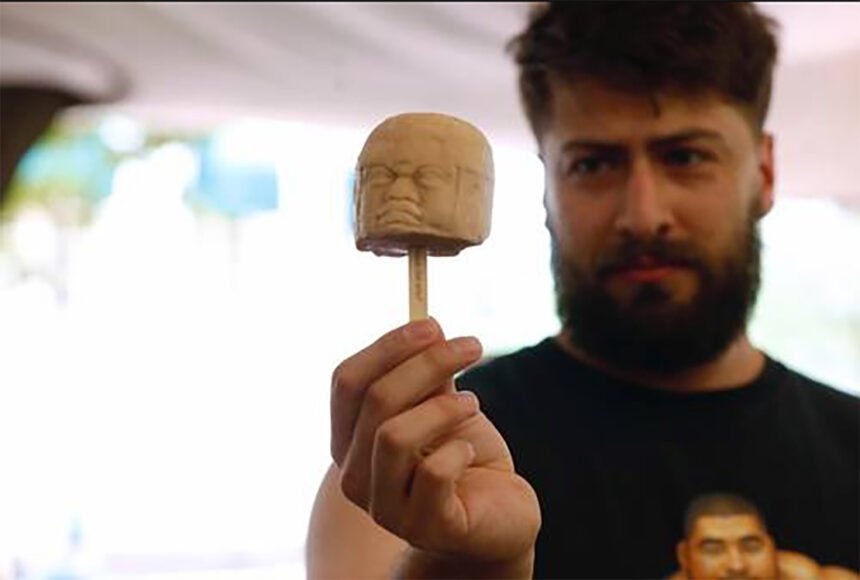When visitors wandered onto the lawn of Casa del Lago UNAM last weekend, gallery staff handed them ice-pops shaped like two examples of pre-Hispanic art. One was an Olmec colossal head, the Mexica deity Xōchipilli, and the other was a bite-sized fragment of the Sun Stone.
But moments after the first pops melted, Mexico’s National Institute of Anthropology and History (INAH) issued a chilly reminder: reproducing any pre-Hispanic object without prior authorization is illegal and can carry stiff fines or even jail time.
The ephemeral treat — equal parts dessert and conceptual sculpture — was the latest activation of Exhibir/desaparecer (“Display/Disappear”), a performance piece by 28-year-old Mexican-American artist-designer Gabriel Lengeling. Moments after the first pops melted in the midday heat, however, Mexico’s National Institute of Anthropology and History (INAH) issued a chilly reminder: reproducing any pre-Hispanic object without prior authorization is illegal and can carry stiff fines or even jail time.
Mexico’s 1972 Federal Law on Archaeological, Artistic and Historic Monuments prohibits unlicensed copies — digital or physical — of pre-Columbian patrimony. INAH told La Jornada that Lengeling “should have requested permission for exhibition, sale or any other purpose.”
The designer admits he skipped that step, arguing that his molds came from Scan the World, a nonprofit 3-D archive hosted on Google Arts & Culture that offers more than 16,000 printable heritage objects under an open license.
“I chose an edible format precisely because the figure will erode and disappear,” he said, framing the gesture as a meditation on how cultural icons are consumed—sometimes literally.
From industrial design to edible pre-Hispanic art
Lengeling was born in 1996 in Guanajuato to a Mexican mother and an American father. This bicultural background feeds his interest in the way symbols migrate and mutate. Trained in sculpture and industrial design, he first gained attention with Aliméntame (Feed Me) at NeoTortillería (2020), an installation where visitors bit into candy replicas of nationalist imagery.
Two years later, during GDL Art WKND in Guadalajara, he unveiled La delicia del objeto inmortal (“The Delight of the Immortal Object”), filling a chest freezer with gourmet paletas that replicated Michelangelo’s Pietà, the Venus de Milo and, again, Xōchipilli. Curator Dea López praised the work for collapsing “illusion, consumption and reproduction” into one sticky experience.
Casa del Lago’s current group show — Conocer el mundo con la boca, sin que te piquen las espinas (“Know the world with your mouth, without getting pricked by thorns”) — explores food as ritual and knowledge, gathering 42 works by 37 artists.
For the opening, Lengeling restaged Exhibir/desaparecer with three Mesoamerican icons, each blended with flavors tied to their symbolism: vanilla for Xōchipilli (the orchid is both native and sacred) and chile-mango for the Sun Stone. He also presented a shimmering mosaic gelatin that freezes a different fragment of the Aztec calendar in amber-colored wobble.
Art or appropriation?
Lengeling insists his intention is participatory, not exploitative. “I want the audience to become part of the piece,” he told reporters. “These objects are our treasures, but they can vanish if we treat them as disposable.” INAH, while recognising the conceptual underpinning, maintains that intent does not override the need for permits. Cultural-heritage attorneys note that even non-commercial, short-lived reproductions fall under the law’s remit.
Beyond popsicles, Lengeling’s studio experiments with edible silicone molds, gelatin mosaics and 3-D-printed candy shells to probe what he calls “the soft underbelly of museum authority.” His works have appeared at Swab Barcelona, Salón Acme and, most recently, the cross-disciplinary “Playa” program at GameplayArts in Los Angeles, where he explored the aesthetics of video-game collectibles in the age of NFT speculation. Throughout, he toggles between kitsch and critique, using sweetness to question whose stories get preserved and whose get licked away.
What happens next
Casa del Lago will keep Lengeling’s gelatin sculpture on view through Sept. 14, but INAH could still pursue administrative sanctions. Whether or not penalties materialize, the incident spotlights a gray zone where open-source technology, culinary art and cultural patrimony collide.
For Lengeling, the controversy is almost on-brand. “The replica liberates the image,” he quipped back in 2022.
In Mexico, liberating the image may now require not just sugar and ice, but also a signature from the nation’s top heritage watchdog.

Yucatán Magazine has the inside scoop on living here. Sign up to get our top headlines delivered to your inbox every week.














